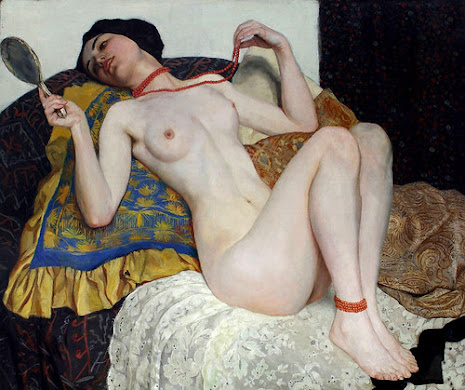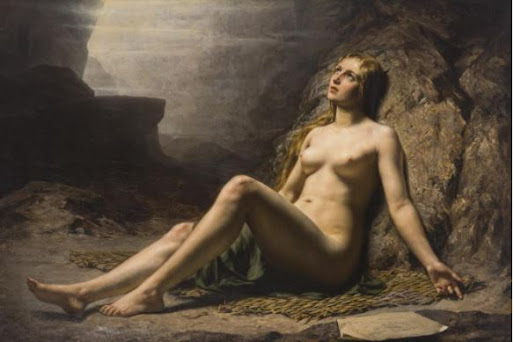PRB
La Japonaise au bain/The Japanese Bather (c. 1865), by James Tissot (1836-1902). Musée de Dijon, France. The model Tissot used for this work was not a Japanese girl but a Parisian model dressed in a kimono. This painting which some would declare as being slightly pornographic was his only depiction of a female nude.
John Singer Sargent, 1891,
Art Institute of Chicago: American Art
It holds the distinction as the only known oil nude of a female that Sargent ever presented. Imposing painting at 6' 1" tall. The identity of the woman who posed in Cairo for this full-length figure study is not known.
Omphale, John Bram Liston Shaw, 1914, watercolor. Queen Omphale asserts her authority by donning the lionskin on the Nemean lion, and holding Hercules' the club. The labors of Hercules are in the background. Byam Shaw ignores the figure of Hercules altogether, showing a triumphant and erotically-charged Omphale (1914), against a background of the twelve labours, in a remarkable reconfiguration of the ancient Roman mosaic.
Bottles, Dante Gabriel Rossetti, 1848, oil on paper mounted on panel, 14.7 × 13.7 in (37.4 × 34.9 cm), with frame: 23 × 22 in (58.4 × 55.8 cm), Delaware Art Museum. Rossetti painted the still life in the foreground of this painting while under the tutelage of Ford Madox Brown (1821-1893). This still life is fraught with images of deep drug-induced sleep. He signed twice, his initials and the artist palette in the right-hand corner. The female figure in the background was probably added in the 1860s. Her facial features suggest it is Fanny Cornforth, a model who was “discovered” in 1856 while Rossetti and others were attending the London city-wide fete celebrating the return of Florence Nightingale from the Crimean War. The drug induced sleep foretells the suicided on his wife Elizabeth Siddal in February 1862 by taking an overdose of laudanum (a tincture of opium containing approximately 10% powdered opium). Siddal had an obsession for the mindless oblivion offered by the drug. Laudanum was the Victorians' favorite drug. Elizabeth Barrett Browning, taking 40 drops a day, largely depended on laudanum to function; and Lord Byron’s daughter, the celebrated mathematician Ada Lovelace, claimed laudanum calmed her overactive mind. By the 1800s laudanum was widely available—it could be easily purchased from pubs, grocers, barber shops, tobacconists, pharmacies, and even confectioners. The drug was often cheaper than alcohol, making it affordable to all levels of society. It was prescribed for everything from soothing a cranky infant to treating headaches, persistent cough, gout, rheumatism, diarrhea, melancholy, and “women’s troubles.” Laudanum became widely used throughout Victorian society as a medicine, and soon many writers, poets, and artists (along with many ordinary people) became addicted. Bram Stoker, Charles Dickens, George Eliot, Dante Gabriel Rossetti, Percy Bysshe Shelley, Lord Byron, and many others were all known to have used laudanum. Some managed to take it briefly while ill, but others became hopelessly dependent. Not only a Victorian problem, in 2019, nearly 50,000 people in the United States died from opioid-involved overdoses. The misuse of and addiction to opioids—including prescription pain relievers, heroin, and synthetic opioids such as fentanyl—is a serious national crisis that affects public health as well as social and economic welfare. The Centers for Disease Control and Prevention estimates that the total "economic burden" of prescription opioid misuse alone in the United States is $78.5 billion a year, including the costs of healthcare, lost productivity, addiction treatment, and criminal justice involvement.
Elizabeth Siddal, Dante Gabriel Rossetti, 1854. Happy birthday Rossetti. Siddall and Rossetti married on Wednesday, 23 May 1860 at St. Clement's Church in the seaside town of Hastings. At the time of her wedding, she was so frail and ill that she had to be carried to the church, despite it being a five-minute walk from where she was staying. Her long illness gave her access to laudanum to which she became addicted. Siddall overdosed on laudanum in February 1862, a great loss to Dante who was consumed with grief and guilt. On Easter Sunday, 1882, Dante Gabriel Rossetti died at the country house of a friend, where he had gone in a vain attempt to recover his health, which had been destroyed by chloral as his wife's had been destroyed by laudanum.
'Bondage', Ernest Normand (1857–1923), 1890, (Slave traders before a pharaoh and his harem in Ancient Egypt). Oil on canvas, 184 x 307cm., American private collector. The Royal Cornwall Museum in Truro sold the painting in 2010 with the original custom frame. They were having a 'funding shortfall' and needed the money for ongoing operations. This is called 'asset-stripping' in the art world. It sold for 1/3 the estimated price. A 2001 Guardian article entitled 'Oh, please put some clothes on' during a Tate exhibition of 'Bondage' said it was 'the most abysmal and the most racist painting in the show.' I can see that. https://www.theguardian.com/theobserver/2001/nov/04/2










Comments
Post a Comment